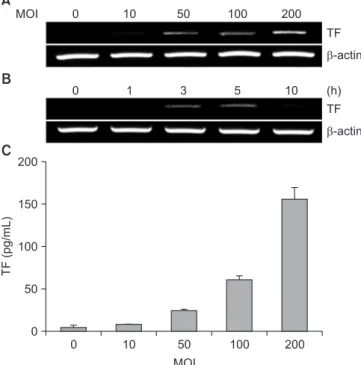Introduction Introduction
Periodontal diseases are among the most widespread in- fectious diseases in humans, and they are characterized by plaque-induced inflammation in the supporting tissues of the teeth [1,2]. A relationship between periodontal diseases and systemic diseases has been increasingly recognized over the past decades. The systemic diseases involved include cardio- vascular disease, gastrointestinal and colorectal cancer, diabe- tes and insulin resistance, and Alzheimer’s disease, as well as respiratory tract infection and adverse pregnancy outcomes [3].
The presence of periodontal pathogens and their metabolic by- products in the mouth may modulate the immune response beyond the oral cavity, thus promoting the development of
systemic conditions [4].
Porphyromonas gingivalis is a well-established pathogen in severe forms of adult periodontal diseases. P. gingivalis is a gram-negative black pigmented anaerobe that colonizes in periodontal pockets and spreads into deeper tissues [5,6]. It has been detected within atheromatous plaques and been shown to induce inflammatory, immune, and procoagulant responses [7,8]. P. gingivalis invades endothelial cells, and it has been proposed that endothelial cell dysfunction is an early manifestation of atherosclerotic vascular disease [9]. There is evidence that P. gingivalis is able to induce and maintain a chronic state of inflammation at distant sites, including athero- matous plaques, and this species has been shown to acceler- ate atherosclerosis in animal models [10,11].
Int J Oral Biol 46:99-104, 2021 pISSN: 1226-7155 • eISSN: 2287-6618 https://doi.org/10.11620/IJOB.2021.46.3.99
Mechanisms of tissue factor induction by
Porphyromonas gingivalis in human endothelial cells
So-Hee Kim, Ji-Yeon Jung, Won-Jae Kim, Ok-Joon Kim, Young Kim, and In-Chol Kang*
Dental Science Research Institute, Chonnam National University, Gwangju 61186, Republic of Korea
Associations between periodontal infection and cardiovascular disease have been documented. Porphyromonas gingivalis is a well-established periodontal pathogen, and tissue factor (TF) is a key initiator of the coagulation cascade. In this context, P. gingivalis has been reported to enhance TF expression in human endothelial cells.
The present study investigated the underlying mechanisms of TF induction by P. gingivalis in human umbilical vein endothelial cells. P. gingivalis increased TF expression in a dose- and time-dependent manner. Not only live bacteria but also glutaraldehyde-fixed bacteria increased TF expression to the same extent. However, sonicates of P. gingivalis did not induce TF expression. Cytochalasin D and SMIFH2, which are inhibitors of actin polymerization and actin nucleation, respectively, inhibited the TF expression induced by P. gingivalis. Finally, TF production was decreased or increased in the presence of various signaling inhibitors, including mitogen-activated protein kinases.
These results suggest that P. gingivalis induces endothelial TF expression by a bacterial internalization-dependent mechanism and through diverse signal transduction mechanisms.
Keywords: Porphyromonas gingivalis, Tissue factor, Endothelial cells
Received June 26, 2021; Revised August 19, 2021; Accepted August 24, 2021
*Correspondence to: In-Chol Kang, E-mail: ickang@jnu.ac.kr https://orcid.org/0000-0002-5993-8728 Copyright © The Korean Academy of Oral Biology
CC

